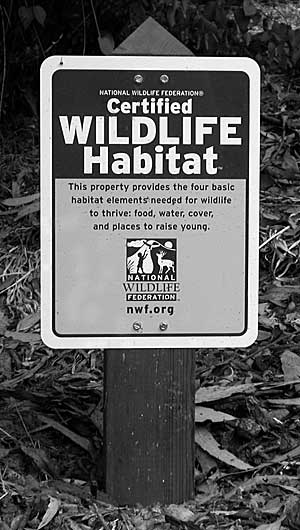Our yard has been certified as wildlife habitat
by Celia Scott
October 2009
When the deer came down the hill behind our house and made a meal of our almost ripe tomatoes last summer, we knew that our yard in the midst of Santa Cruz was a de facto wildlife habitat. Not that we were totally surprised, after discovering that early crops of persimmons and walnuts disappeared without a trace (raccoons, squirrels?) and pears not picked promptly became bird food. We have an extraordinary number of bird species that arrive at our feeders throughout the year and inundate our garden during the fall migrations to consume as many red berries as their little bodies can hold.

Photo by Peter Scott
Birds nest in our yard; bees and butterflies make themselves at home; and a few days ago a gopher snake slithered down our driveway. We also have gophers!
By chance I read an article in On Earth, the magazine of the Natural Resources Defense Council, about a property owner in Arcata, CA who had her 6000 square foot urban home site certified as a wildlife habitat by the National Wildlife Federation (NWF). Since 1973 NWF has certified over 113,000 habitats nationwide, including private properties, more than 3100 schools, restaurants, hospitals, places of worship, community parks, corporate buildings, and municipal facilities.
The new knowledge spurred me to action. I obtained a habitat certification application from NWF, filled it out, and sent it in with a $15 fee. In order to be certified, a property must provide four basic elements: food, water, cover, and places to raise young. The property must also be cared for with sustainable gardening practices. We were certain our yard would qualify. We had the four basic elements, and for years we have avoided the use of chemical fertilizers and pesticides, used native plants as much as possible, have no lawn, and practice composting.
A few weeks later our Certified Wildlife Habitat certificate (suitable for framing) arrived, and we ordered a weatherproof, recycled aluminum sign which is now posted along our driveway. We now put netting over our tomatoes and line our herb and vegetable beds with wire to protect from gopher intrusion. The pleasure we gain from sharing our yard with our wildlife friends easily compensates for the loss of some edibles. Additionally, there is the satisfaction of knowing that we have taken some small steps toward ecological balance and a healthy, livable planet for all creatures.
If you are inspired to seek certification for your own corner of the world, explore the certified wildlife habitat program of the National Wildlife Federation at www.nwf.org/habitat or call 1-800-822-9919.
< back to all issues

